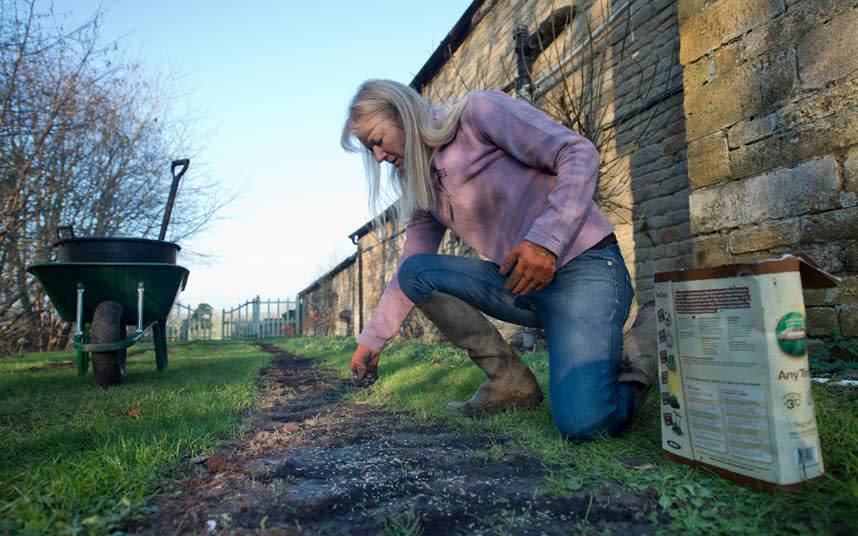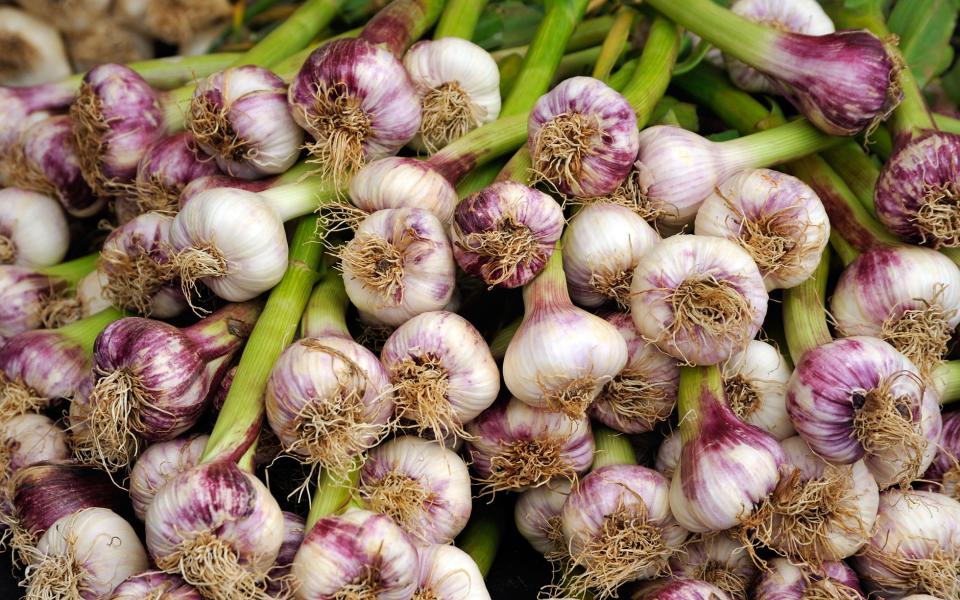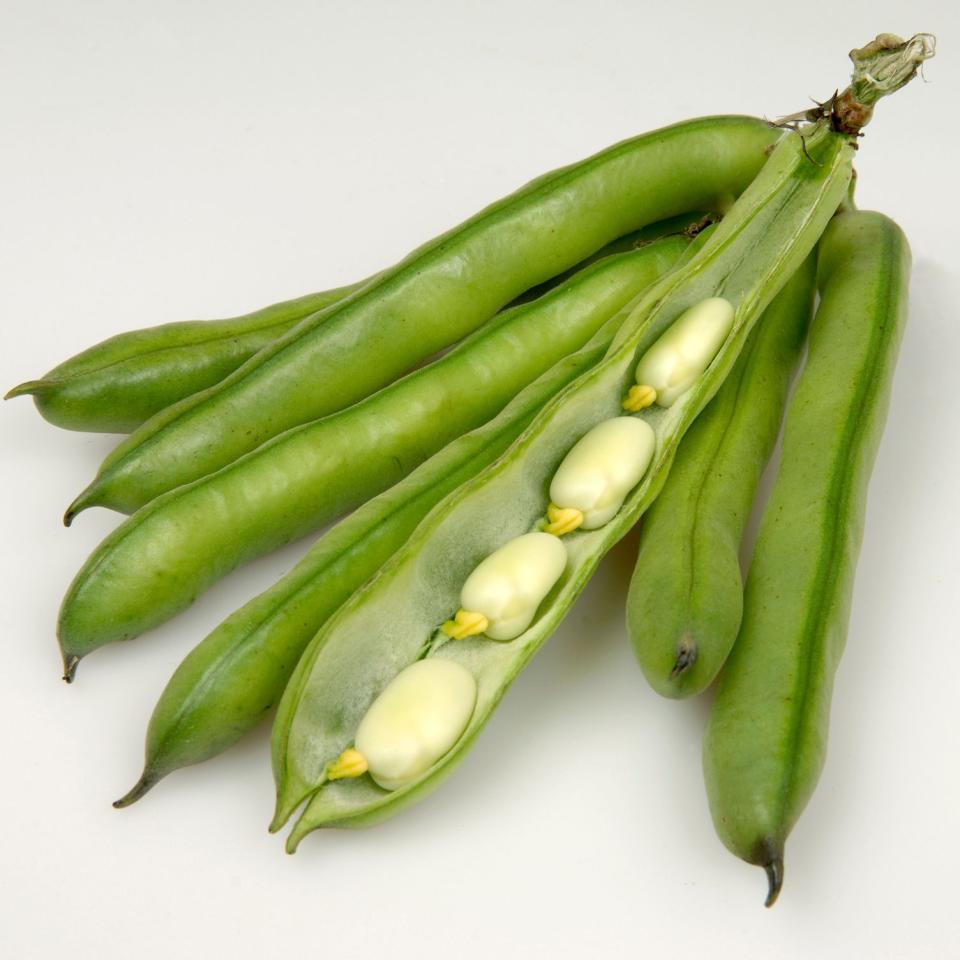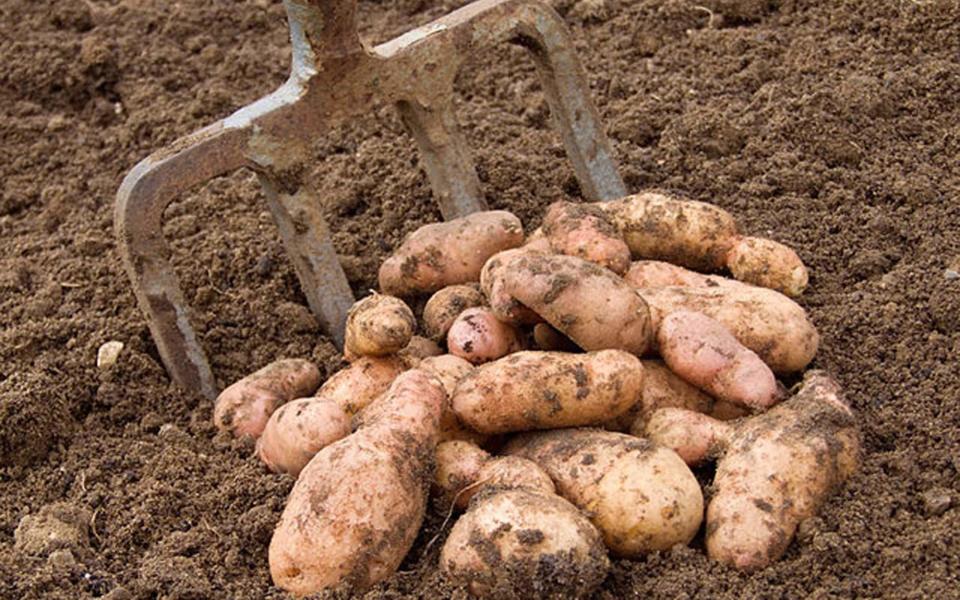Gardening in January: what to plant and tidy in your garden this month

Provided the ground is not frozen, this time of year is a good opportunity to plant bare-root roses. This winter I am planting three plants of opulent, ruffled, deep purple 'Charles de Mills’, a gallica rose, highly scented and perfect for edible use, just in case I fancy mixing handfuls of petals into a perfumed, summery cake.
Sow radishes
Having said all that, I have chanced a proper sowing of radishes this week, in pots in the greenhouse, tucked up with horticultural fleece for warmth. 'Mirabeau’ is a fine variety for early sowings, cylindrical and shiny red and white.
Houseplant TLC
My houseplants are looking desperate: central heating is not their friend. Give them a treat by wiping their leaves then standing them on trays of pebbles and water to increase the humidity around their poor, dried out leaves.

Super dahlias
Dahlia cuttings produce bigger flowers than tubers. So pull your tubers out of dormancy, nestle them into trays, water, then stand them on a heated propagating bench. When the shoots reach 3-4in you can start taking cuttings.
Cut backs
January calls for clean sweeps and I find myself itching to clear collapsed herbaceous plants. I try to leave most stems to provide homes for insects but chop out the bent stems and pile them in a corner so the bugs can snooze until spring.
Sprouts in jars
The urge to sow is getting stronger, but its outlets are still necessarily limited. A jar or three of sprouting seeds will fend it off until a more sensible time of year, and provide fresh, crunchy salad ingredients, too.
Take a handful of chickpea, mung bean, lentils, alfalfa, pea or daikon radish seeds and soak overnight, then tip into a jar and “wash” them twice a day, draining thoroughly each time, until they are sprouted and ready to eat. See sproutpeople.org for more ideas.
Sprinkle ash
Collect up ash from your all-wood fires (i.e. only those without coal) and sprinkle it around fruit trees and roses. It is rich in potassium, so encourages good flowering in spring, and hence good fruiting in autumn.

Set for sowing
Get your spring sowing kit sorted out now. My checklist: labels, module trays, seed compost – I particularly love Carbon Gold (carbongold.com) and a couple of markers – Sharpies are good. After a morning washing pots I’ll be raring to go.
Time to choose tomatoes
It’s time to buy tomato seeds, for sowing late next month, and one of the most impressive ranges is offered by Simpson’s Seeds (simpsonsseeds.co.uk). Their catalogue has good, honest descriptions without too much hyperbole to help you choose the best varieties for your own situation. I’m going for 'Mortgage Lifter’, 'Costoluto Fiorentino’, 'Sungold’ and 'Indigo Beauty’ to fill my polytunnel and my salad bowl.
Perennial help
Clear away fallen leaves wherever they lie over the shoots of bulbs or the crowns of perennials. This will give fresh spring growth the best chance of emerging unscathed and beautiful.
Also in January Sow early-cropping peas
Fresh peas straight from the pod are the only green vegetables my children show active enthusiasm for, so I do consider it my parental duty to attempt an early crop. Early types such as 'Feltham First’ and 'Early Onward’ are hardy and can be sown now, into deep pots. Plant them out in four to five weeks when the shoots are a few inches long. Pinch out the tips to encourage branching and you’ll be picking as early as May.
Look after birds
On frosty mornings check your bird bath and melt the ice with a little boiling water. Hanging a fat ball will also help make your garden a life-saving calling point on these chilly days.
Prune fruit
Prune your apple and pear trees. The general aim is to open up the centre, creating an elegant “goblet” shape. Remove dead and diseased branches completely, then reduce by a third the longest branches.
Order berries
Order and plant out bare-root raspberries: much cheaper than container grown and often quicker to establish, too. I am planting a row of yellow 'All Gold’ and deep purple 'Glen Coe’, for rainbow fruit salads.

Prune buds
Buddleias love a hard prune, and this is the time to do it. There is no real trick to this, just lop them off right down to the base: you will have a neater – if they can ever be called neat – and more floriferous butterfly bush as a result.
Choose a witch hazel
This is a fine time to plant deciduous trees, and also of course to choose one for winter interest. I love witch hazel – incidentally at its most striking when producing its spidery, citrus-scented flowers in front of a deep-green yew hedge background. Witch Hazel Nursery in Kent maintains a National Collection of hamamelis and has its annual open day tomorrow, where you can view more than 500 plants, hopefully in flower. See witchhazelnursery.com for details.
Mower check
Don’t wait until spring to check your mower over, or you will find yourself at the back of the repair shop’s queue as the grass grows long. Clean it of old, dry grass, oil it, and start it up just to check.

Hunt out weeds
This is an excellent moment for searching through borders and digging out perennial weeds that were hidden by growth all summer. Use a fork to ease them out, roots and all, and be one step ahead of them come spring.
Think about evergreens
It’s not the time for planting evergreens, but it really is the time for noticing that you need some. Brown and skeletal can be delicately beautiful, but needs something solid and green to shore it up. Consider where a fence might benefit from a scramble of glossy ivy, a corner could be concealed by a holly, where a little line of box might meander among the seasonal wreckage, and make notes for planting later, as winter’s grip softens.
Grab the garlic
If you haven’t planted garlic, there is still time. I plant into the tops of ridges, and go for the more dependable soft-neck types such as 'Solent Wight’, rather than trickier hard-neck types. But you can find all at thegarlicfarm.co.uk.

Protect dwarf nectarines
I have two dwarf nectarines 'Nectarella’ in big pots on my veranda, grandly straddling the steps to the garden, and at this time of the year I pull them back and tuck them more definitely under the veranda roof. The rain early in the year activates spores of peach leaf curl in the soil, which will distort the leaves and make them drop prematurely. Bring your pot-grown dwarf peaches and nectarines under cover, and spread a sheet of polythene and fix in place over wall-trained plants.
Cover winter veg
I still have plenty of Oriental mustards and parsley in the ground, as well as a few winter lettuces, but they look mud-splattered and unappetising after rain or hail. Cover leafy winter veg with cloches and new leaves will be much more tempting.
Sow beans
There is still time to sow broad beans: I do it once outdoors in autumn, once now under cover, and, finally, outdoor sowing in April.

Sow hardy 'Aquadulce Claudia’ or 'Super Aquadulce’.
Pick sprigs
Pick the occasional sprig of winter scented shrubs lonicera, sarcococca and daphne and bring them indoors, where they will fill the entire house with their spring-like scents.
Build up
Get new garden infrastructure in now. I have put in an archway and a pair of matching obelisks: they provide height and structure and are in place in time for plants to scramble up them.
Cut hazel support poles
I cut down the three hazel coppices on my allotment in rotation, one every couple of years, partly because I don’t want them to annoy the neighbours, but mainly because they make such excellent support poles for climbing plants: sturdy and rustic. Do it now, as they don’t keep so well if they are cut once the sap has started to rise. Any side branches make excellent pea sticks.
Check for frost
Make sure newly planted trees and perennials haven’t been lifted by frost, and firm them gently back into the soil with your boot if they have.
Fresh water
Clean out your water butts: few plants need watering now and we can be fairly sure of more rain to come. Drain, then scrub out with hot water and a stiff brush, or blast them with a power washer if you don’t mind a bit of slime in your hair.
Make a bean trench
A bean trench makes the most of winter kitchen scraps, turning them into summer growth and bounty. Dig a trench at least one spit deep and as long as you wish your bean row to be. Line the bottom with newspaper and water well, then periodically drop in kitchen peelings and rabbit and guinea pig bedding and leavings. By planting time it will be full, and the richest possible soil for greedy beans to sink their roots into.
Fork lawns
Winter weather lays bare all my lawn’s shortcomings. Make a note to get onto the lawn during drier spells to push a garden fork straight down into it at intervals of about 12in (30cm), so allowing water to drain away.
Snip sweetpeas
If you sowed sweetpeas in autumn, nip out their tips now, or cut them right back to a few leaves if they are drawn up and leggy. Even if you didn’t then all is not lost: sow now. I’m going for old favourite 'Matucana’ for scent and 'Prince Edward of York’ for pizzazz.
Ties that bind
Check the ties on young trees for looseness and stakes for wobbles. Some of the wildest winter weather could still be ahead of us.
Take a bough
If you forgot to put out your Christmas tree for recycling, here are a few uses: cut boughs and lay over the crowns of perennials to protect from frost; use the needles as a mulch around acid-loving plants; bundle a few boughs and stow in a corner as a wildlife hotel.
Basket cases
A little care for those pots and baskets of yellowing Christmas bulbs and they could bloom another year. Water and feed them well and plant outside or, if the weather is cold, tend to them on the back step or some other sheltered spot so they die back in their own time, then plant them out.
Potato days
January is the month for potato buying.

The best source of the best possible varieties – and to buy in handfuls rather than bagfuls if you favour diversity over bulk – are potato days, held in village halls and garden centres around the country. Have a look at homefarmer.co.uk/potato-days to find your nearest.
And so to beds
A few of my allotment beds are still covered in old growth. To avoid getting caught short by the spring rush, with seedlings that have no place to go, now is the time to pull up the mess, chop it on to the compost heap, fork out weeds, then cover beds in a thick layer of compost or well-rotted manure.
Turn up the heat
Order chilli seeds for sowing over heat next month – Sea Spring Seeds is my supplier of choice. I’m trying 'Mulato Isleno Poblano’, the ancho chilli – complex in flavour and essential to Mexican cuisine – and 'Bellaforma’, a Tobagan “seasoning pepper” with a rich, fruity flavour and a touch of heat. You may be braver with the Scoville units (seaspringseeds.co.uk).
Rosemary’s time
Just as the garden is at its bleakest and brownest, rosemary is flowering its heart out, a boon for gardeners, cooks and the odd confused bee. The flavour is a honeyed, subtle version of the leaf; sprinkle a handful over a winter salad of chicory, walnuts, apples and goat’s cheese, or over bowls of stewed apples and custard.
Rhubarb road
Thrillingly, it is time to force rhubarb, always an encouraging marker on the road to spring. Cover your clump now with straw and a light excluder: a big bucket or upturned dustbin does the job, but a proper terracotta rhubarb forcer looks much lovelier.
Catch the cold
Seeds of native trees and shrubs need a period of cold to germinate, so if you have collected seed this is your last chance to sow into pots of gritty compost. Place in an open cold frame or up on a garden table (to give the seeds a fighting chance against marauding mice).
Bristol-based gardener, writer and cook Lia Leendertz has a 'slightly larger-than-average’ town garden and an allotment. Follow her on Twitter @LiaLeendertz


